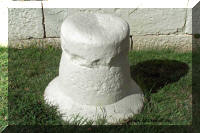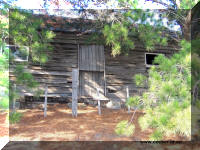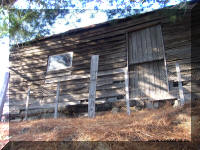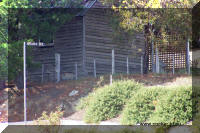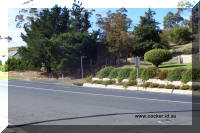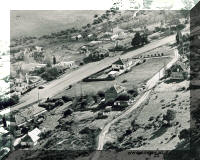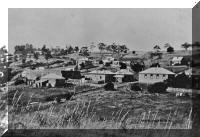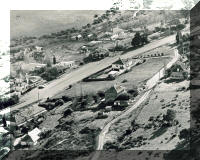Life and Death in Pontville
On March 1862, James was witness to the marriage of Charles Albert Hodges, painter, 35, to Sarah Holden, spinster, 19, at St Augustine's Church, Broadmarsh. The other witness was Susan Holden.
The wedding was probably held in Broadmarsh because there was no Catholic place of worship in Pontville until St. Matthews was opened in 1867. Plans had been made as early as 1854, but most Catholics were either former Irish convicts or poor immigrants, so fundraising was a slow business. Meanwhile, services were held in the Pontville police station.[7]
Families could rent pews in the new St Matthews. In Planting a Faith in Tasmania, Terry Southerwood listed 13 heads of households who used the system. The list was headed by prominent citizens Thomas Stanfield and Francis McShane. James was in tenth place.[8]
Considerable effort has been made to establish definitively the location of the Hally household(s) in Pontville. Some mystery remains, but it is likely that James and Margaret, at least until she became a widow, lived in just two places.
Whenever James and Margaret shifted to Pontville, they probably occupied a cottage in Lythgo's Row. This set of conjoined houses and a shop had been constructed by William Lythgo in the late 1840s. Archaeological evidence suggests there was a smithy at the northern end of the building. The sandstone blacksmith's leg rest pictured below can still be found oustide Lythgo's Row today. The 1858 Valuation Roll lists three smithies in the district of Brighton, but James is shown simply as occupying, but not owning, a cottage and garden in Pontville. The 1861-62 Electoral Roll has William Lythgo as his landlord. The inquest into the death of Margaret in 1861 implies the smithy was close to the Hally living quarters.
The 1867 Valuation Roll has James with two cottages and a smithy, with the owner now Sarah Lythgo, the widow of William. It makes sense to think the Hallys spread from one to two parts of the Row as the family grew.
This is the number of the children through the years:
1855 – 1 Mary
1856 – 1 Mary+ James born and died
1857 – 2 Mary + Margaret
1859 – 3 Mary, Margaret + Ellen
1861 – 2/3 2 after Margaret died, 3 after Julia was born
1864 – 4 Mary, Ellen, Julia + Kate
1867 - 5 Mary, Ellen, Julia, Kate + Bridget
1869 - 6 Mary, Ellen, Julia, Kate, Bridget + Nicholas
1870 - 7 Mary, Ellen, Julia, Kate, Bridget, Nicholas + Margaret
The present interior of the Row cottages indicates a family of two adults and four children under 10 could have fitted into one cottage in 1864 – Kate in a cot in the parent’s room and the 3 girls top-and-tail in the other upstairs room (now an open area at the top of the stairs but possibly separated by a wall then). By 1867, with Bridget arriving, it would have been becoming quite a squeeze. And James’ business would have been well-established by then, so he could have been able to afford the rent for a second cottage.
By January 1868, about a dozen years after arriving in Pontville, James had prospered sufficiently to become a proprietor. He arranged a loan of 100 pounds and in February completed the purchase of a Princes Street property, previously owned by a blacksmith, James Undy. Presumably, this property contained two cottages and a smithy as shown in the 1869, 1871 and 1872 Valuation Rolls. It seems from the Rolls that the Hallys were the only residents on the Princes Street property and must, therefore, have been using both cottages – one as a main residence and the other as either part of the smithy or as bedrooms for the older girls. (In 1868, Mary turned 13, Ellen 9 and Julia 7.)
The 1869 Valuation Roll has James as the owner as well as the occupier of Cottages and smithy, under one acre, with a Gross Annual Value of 19 pounds 16 shillings and a Net Annual Value of 18 pounds.
For 1871, the rateable value of the cottages and smithy had fallen to 15 pounds. The following year saw a further fall, to 12 pounds. For some reason, James did not appear in the 1873 Valuation Roll at all.
Dr. Edward Swarbreck Hall, mentioned the Hallys in a notebook he kept in 1875:
James Hally, the Pontville blacksmith, and his 6 children lived in 8 unventilated rooms, which opened at the back onto a mass of stinking filth flowing out at the back within (distance) of the river - says he boils the water from the River at the back, says he has no cow at present.
By 1879-80, James had a house and shop. With just four of the children aged under 18 – Kate 15, Bridget 12, Nicholas 10 and Margaret 9 – James may have been using the second cottage as a shop for blacksmith gear, or had he moved to the building which was known in the twentieth century as Hally’s smithy, on the corner of Glebe Street and the Highway?
Tasmania’s first Post Office Directory, for 1890-91, has James as one of three blacksmiths at Pontville – the others were Martin Blake, his son-in-law, and Henry Green. For the directory of 1892-93, James is joined by his son, Nicholas, by then aged about 23.
In the 1899 Post Office Directory, under the listing of “Smiths, blacksmiths and farriers” at Pontville were James Hally, Henry Green and a John Suter, who also covered Brighton Junction.
The 1900 Electoral Roll has James as occupier of a Pontville house and Nicholas as the owner. But the 1901 Valuation Roll shows James as the owner of a cottage and land, under one acre, with an annual value of 9 pounds and a capital value of 75 pounds.
It is likely, as Nicholas followed his father into the blacksmithing business, that the son inherited his father’s smithy in 1903. The fact that 2 Glebe Street was not purchased until 1913 seems to indicate James stayed in Princes Street until his death in 1903 and that it was Nicholas who set up the business on the Highway. It may be that Nicholas used Glebe Street long before buying it and that James worked there with him for some time. Here are several recent pictures:
The Pontville Historic Environment Study, a National Estate project for the Brighton Council in 1995, claims the former blacksmith shop on the Highway was built by James in the mid-1850s. Elsewhere in the report, 1880 is named as the approximate date for the construction of the smithy. There doesn’t appear to be any evidence to back either assertion, but the latter date appears the more likely.
Nevertheless, the authors recommend the building be preserved because of its “important contribution to contemporary understanding of how life really was in a historic village.”[9]
Another timber building from the same era, a bakery, just north on the Main Road, has also survived. If the recommendations from The Pontville Historic Environment Study of 1995 are followed by the Southern Midlands Council, they may both last much longer. The authors called “Sidney’s bakery and Hally’s blacksmith shop…central to the commercial character and contrasting fortunes of the village.”[10] At the time of writing – November 2014 – the buildings remain.
Death in Pontville
James’ death of 11 July 1903 was registered by Nicholas, who noted his father as having lived in Australia for 51 years (actually 50 years, 5 months and 15 days), and as having been born in Ireland. The cause of death was bronchitis and senile decay, according to Dr. Crowther.
The following notice was inserted in The Mercury of 18 July:
Hally - On Saturday, July 11, at Brighton, James Hally, aged 76 years. Funeral will leave his late residence at 3 o'clock on Tuesday for St. Matthews Church, Brighton. Friends are respectfully invited to attend. R.I.P.
An obituary, reproduced later, was published in The Mercury on 15 July 1903, page 6.
Margaret survived James by four years, before dying on 25 November 1907.
The following notice appeared in The Mercury the next day:
HALLY - On November 25, at her daughter's residence, Brighton, Margaret, relict of the late James Hally, in the 73rd year of her age. Funeral at St. Matthews Church, on Wednesday, November 27, at 3 p.m. Friends are respectfully invited to attend. "Requiescat in pace."
The daughter would have been Mary McLoughlin.
Table of Contents
- James Hally in Ireland
- James' Journey
- James in Hobart
- Margaret Casey in Ireland
- Margaret's Journey
- Early Married Life
- The Family
- Life in Pontville
- James Hally the Activist
[7] TAHO, CSO26/5506
[8] Planting a Faith in Tasmania, Terry Southerwood, page 25
[9] The Pontville Historic Environment Study, Part 2, Appendix 2 Notes for Existing Built Structures in Pontville MacFie, Morris-Nunn and Dudley, a National Estate Project for the Brighton Council, 1995
[10] The Pontville Historic
Environment Study Part 1 A Social History of Pontville,
MacFie, Morris-Nunn and Dudley, a National Estate Project for the
Brighton Council, 1995, page 9

